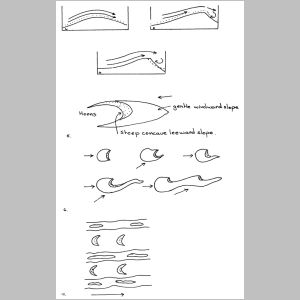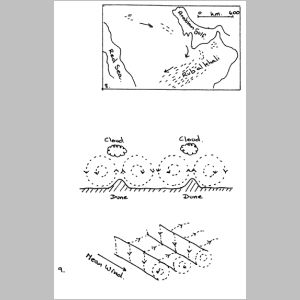Bulletin 17 - July 1982: Sand Dunes Made Simple
Sand Dunes Made Simple
by P.H. YatesOne of the more interesting geographical features of Arabia is the presence of a large sandy desert. Contrary to popular belief sand comprises only a small proportion of the world's deserts, though the Rub 'al Khali ('Empty Quarter') happens to be one of the largest areas of continuous sand. Its origin is vague, suggesting a marine source. However, since a variety of sand types exists, the origins of the Rub 'al Khali are probably more complex.
Sand dunes occur in many forms, but their formation has one basic cause -- the transport of sand by the wind. Sand particles begin to move when wind velocity reaches about 20 kph. The smallest particles (0.05-0.15 mms. in diameter) are so tiny that they float in the air: this is known as suspension. Slightly larger particles (0.15 -0.25 mms. in diameter) move in a hopping motion known as saltation. (Figure 1.) Turbulent air flow at the surface causes the particles to rise, and the grains then fall with a gliding movement. Above some surfaces particles have been recorded up to heights of two metres. Pebbled surfaces seem to produce the highest flight paths. The energy of the falling grains may not be completely absorbed on impact and may therefore rebound. This may cause another particle to jump or may push a larger grain (0.25 -2 mms. in diameter) forward. These larger grains are continually bombarded by saltation and being pushed forward: this is known as sand creep.
Closely linked to the process of saltation is the formation of sand ripples. These tend to have a regular wavelength determined by wind velocity. Ripples form an irregular surface that allow the buildup of sand (Figure 2), but are restricted in height by the velocity of surface winds. Once the crest of a ripple begins to interfere with the airflow it is pushed over into the next hollow.
On a slightly larger scale low ridges may be formed of coarser material and again this feature is associated with saltation. Most of the finer grains are removed, leaving the larger ones to be pushed along by the impact of saltation. These coarse grains build up to form ridges at regular intervals. Hollows are enlarged on the windward side by sand creep towards the crest and on the leeward side by the fact that very little new material is received. Obviously as the ridges are continually being built up materials will fall into the leading hollow allowing for the slow advance of the sand ridges.
Traditionally, sand dunes have been divided into two basic types -- seif dunes and barchans. However, many other types have been recorded (Figure 3). Seif dunes are formed by winds flowing from more than one direction and barchans by unidirectional winds. Barchans develop from mounds of sand, the wind pushing grains to the crest where the accumulation threatens the angle of rest. Once this is exceeded the leeward face of the mound collapses and permits a forward movement (Figure 4). The flanks of the mound also advance rapidly, creating the characteristic horns of a barchan (Figure 5). The horns stop advancing when they become sheltered by the main body of the barchan.
Seif dunes are thought to develop from barchans if a change of wind direction occurs. The new wind direction will lead to the development of a new wing and the overdevelopment of one of the original wings. If the prevailing wind then becomes dominant for a lengthy period of time the dune will revert to its barchan form, with one exaggerated wing. Should the strong wind then return the exaggerated wing will further extend so that eventually it will be supplied with sand when the prevailing wind returns. The wing will continue to grow under both wind conditions, thus producing a seif dune (Figure 6). On a seif dune the slip face develops on the side facing away from the strong wind, while the slip face of a barchan faces the direction of movement. In the sheltered troughs between highly developed seif dunes barchans may be formed because the wind is unidirectional (Figure 7).
It would be wrong to assume that all dunes take on the basic forms described above. The geometric form of sand dunes varies according to the variables of sand supply, wind regime, vegetation cover and surface shape. In areas with little sand it is common to find barchans or star-shaped dunes if the wind direction is not consistent. Continuous systems of transverse dunes depend on a large thickness of sand or form where sand is checked by a topographical barrier.
Just as the size of sand particles determines the method of movement, the same is also true of dune shape. Fine sand particles tend to produce a strong relief, the dunes having a short wave length, while coarse sand produces rounded dunes with a long wave length.
The overall pattern of dunes in Arabia is one of long ridges roughly following the wind pattern (Figure 8). Once established this dune pattern is maintained by the presence of corkscrew-type winds generated by air rising on the dune sides (Figure 9). Evidence of this type of wind movement is demonstrated by the presence of cloud 'streets'in satellite photographs.
Though by no means a definitive study, it is hoped that the above should give the reader some idea of the mechanics of sand dunes, but we should also remember that no two dunes are alike.
Bibliography:
- General Geography in Diagrams
- R.B. Burnett. Longmans, 1979
- Desert Geomorphology
- A. Goudie and A. Watson. Macmillan, 1980
- Geomorphology
- B.W. Sparks. Longmans, 1972
- The Face of the Earth
- D. Dury. Pelican, 1966


